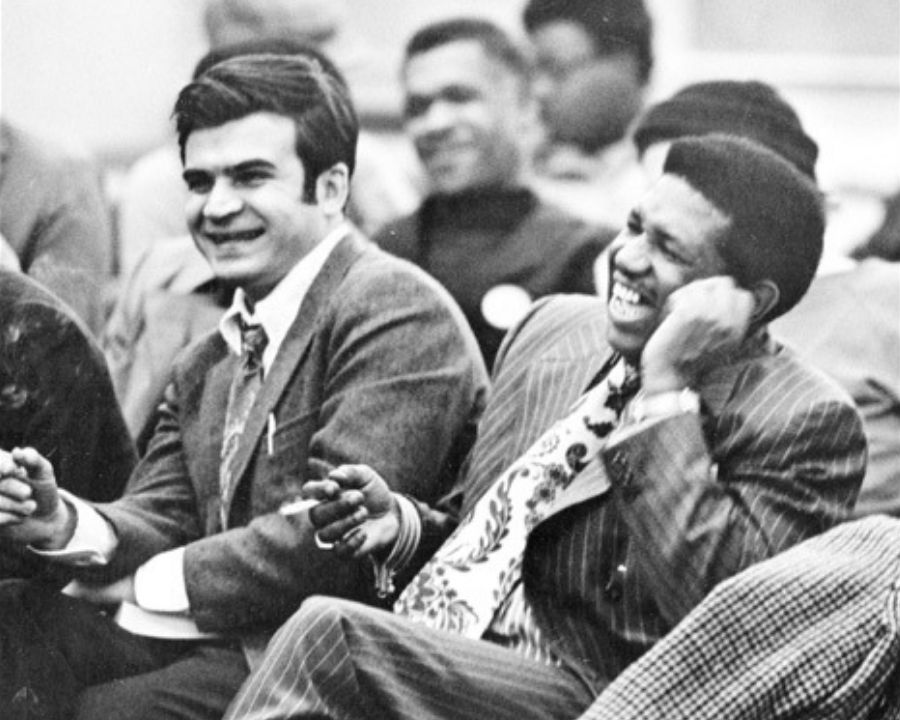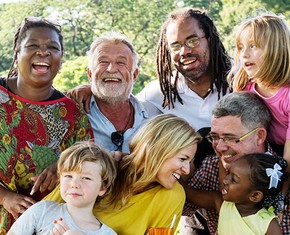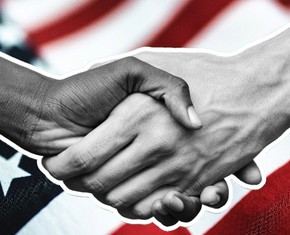The views expressed in our content reflect individual perspectives and do not represent the authoritative views of the Baha'i Faith.
During my early years in the United States as a poor immigrant, I worked shoulder-to-shoulder with black Americans and got a glimpse into their lives and struggles.
A foreigner struggling in this new society, I felt a sense of kinship with the difficulties of my black co-workers who, like me, were often viewed with suspicion and were more likely to be mistreated than white persons. We worked hard for low pay in harsh conditions in restaurant kitchens and in other menial jobs, often for cruel, unkind bosses, and those experiences gave us the bond of struggle.
 The Civil Rights Movement also appealed to us as young Persians who hoped to create a more open, democratic and egalitarian society in Iran. I joined a group of Persian friends driving to the March on Washington in 1963. We had no money for a motel, so we slept in the car. We wanted to be a part of this exciting moment in history. We witnessed what would later come to be seen as the iconic moment of the emerging Civil Rights Movement.
The Civil Rights Movement also appealed to us as young Persians who hoped to create a more open, democratic and egalitarian society in Iran. I joined a group of Persian friends driving to the March on Washington in 1963. We had no money for a motel, so we slept in the car. We wanted to be a part of this exciting moment in history. We witnessed what would later come to be seen as the iconic moment of the emerging Civil Rights Movement.
This movement had started during the more conservative late 1950s when bus boycotts and sit-ins, led by the charismatic and inspiring figure of Dr. Martin Luther King, Jr., challenged the decades-long Jim Crow laws. With his powerful persona out front, and a growing public awareness and acceptance among white people of the reality of racial injustice, the movement made substantial inroads, resulting in the Civil Rights Act in 1964 and the Voting Rights Act of 1965.
With that success, a more radical strain emerged in the movement, which used the phrase “Black Power.” The outbreak of riots in American cities eroded some of the support for civil rights among white Americans who were shocked by the urban unrest. The murder of Dr. Martin Luther King, Jr. ended the idealistic phase of the movement – but as a Baha’i, I continued believing in and working for the oneness and unity of the entire human race:
For a single purpose were the Prophets, each and all, sent down to earth; for this was Christ made manifest, for this did Baha’u’llah raise up the call of the Lord: that the world of man should become the world of God, this nether realm the Kingdom, this darkness light, this satanic wickedness all the virtues of heaven – and unity, fellowship and love be won for the whole human race, that the organic unity should reappear and the bases of discord be destroyed and life everlasting and grace everlasting become the harvest of mankind. – Abdu’l-Baha, Selections from the Writings of Abdu’l-Baha, p. 30.
Finally, the excitement of the times and the stability of my marriage helped me to let go of my foreignness and engage in the issues of the society around me. Inspired by the Baha’i teachings and by the global movements against prejudice and racism, I joined a fledgling school organized by Catholic sisters, black ministers and Baha’is, dedicated to social change: the Harlem Prep School.
 The streets of Harlem were a long way away from the dirt lanes of my small hometown in southern Iran, and yet Harlem was where I found myself in the late 1960s, working as an administrator at the innovative Harlem Prep School.
The streets of Harlem were a long way away from the dirt lanes of my small hometown in southern Iran, and yet Harlem was where I found myself in the late 1960s, working as an administrator at the innovative Harlem Prep School.
Harlem Prep was a fruit of the times, which demanded social justice and change.
America’s post-World War II prosperity, the Kennedy administration and the powerful civil rights movement provided the momentum for addressing long-standing social and economic woes. President Johnson proposed the creation of a Great Society through the active involvement of the Federal government. One of the largest legislative efforts in American history, Johnson’s Great Society aimed to alleviate poverty and advance civil rights. The Federal government now took part directly in addressing issues involving civil rights, poverty, education, health, housing, voting rights, pollution, the arts, urban development, occupational safety, consumer protection and mass transit.
One of the glaring needs in central Harlem was for a college preparatory high school for at-risk youth. To remedy this, Reverend Callender partnered with Manhattanville College, a school run by the Order of the Sacred Heart. This collaboration followed in the Urban League’s tradition of interracial collaboration.
The Vatican II Council had revolutionized the work of the Catholic Church, and as a result all of its orders became more involved in the life of civil society. Manhattanville College already had a long Christian tradition of student volunteerism. For decades, its students had served in neighborhoods in need, such as Harlem. Sister McCormack, the president of the college, knew the prominent leaders in Harlem and decided to work with Reverend Callender developing a college preparatory school in Central Harlem for at-risk youth. She put the implementation of the project in the capable hands of Sister Ruth Dowd, who was excited, though nervous, about her new responsibility. In June of 1967, Reverend Callender and Sister McCormack signed a memorandum of understanding to found an alternative to the troubled public school system: the Harlem Prep school.
The school opened in an old armory with 49 students – over 200 had applied – and by the end of the year the enrolment topped 79 students. The efforts of that first year bore fruit when all of its students were accepted to colleges. With the help of funding from the Mosler Foundation, Union Carbide, the Urban League, the Astor Foundation, the Ford Foundation and Coca-Cola, the school took up its permanent home in a refurbished supermarket, with new furniture donated by the designer Herman Miller. The new space would allow the school to substantially increase its student size. The interior had a large open layout, with a huge skylight through which light flooded in. The curriculum had a flexible design which included student input. The schedule was modular, with classes of varying lengths.
Most importantly, the Board of Harlem Prep found a dynamic leader in the Baha’i educator Ed Carpenter, who had the ability to inspire others with a vision of improving the lives of young people. He didn’t see the students as “drop-outs,” but rather as “force-outs;” kids pushed out by the indifference and tedium of the public system. Along with Ed, his wife, Ann worked tirelessly organizing the tedious details of school administration such as schedules, teacher training and supervision, and materials.
I heard about the Prep because of my association with Ed and Ann, who were both Baha’is and whom I liked and admired greatly. One couldn’t help but feel that way about both of them and be inspired by their vision for young people. My experience as an immigrant trying to eke out a living in hot and crowded kitchens, and the vilification I had weathered as a Baha’i in a small Iranian Shi‘a Muslim town, made me open to trying to understand the struggle of black Americans against racism and the Jim Crow state.
















Comments
Sign in or create an account
Continue with Googleor